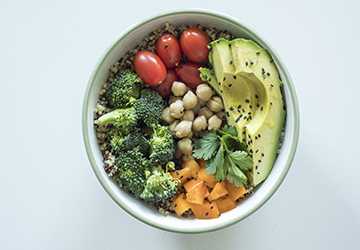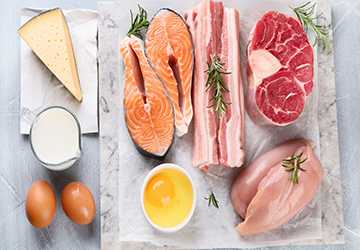How to Create a Balanced Vegetarian Diet Plan
Starting a vegetarian journey is more than just a change in diet; it's a smart choice for a lifestyle focused on personal well-being and environmental sustainability. Creating a balanced vegetarian meal plan isn't about sacrificing flavors or nutrition; This is an exploration of various plant-based foods that nourish our bodies in extraordinary ways. This guide explores the art of creating a balanced vegetarian diet that emphasizes simplicity, variety, and essential nutrients that promote a thriving Spartan lifestyle.

Plant protein powder
Protein is the cornerstone of a healthy diet, and you can quickly meet your protein needs through plant sources. Your goal must be to include different sources of protein in your diet. This can consist of lentils, tofu, beans, and quinoa. Remember the nuts and seeds - sprinkle them on your salad or grab a handful for a filling snack. By diversifying your protein sources, you can ensure you're getting the complete amino acids your body needs.
Colour your plate with vegetables.
A living plate is a healthy plate. Eat various vegetables to ensure you get a wide range of nutrients. Different coloured vegetables bring different health benefits. Green leafy vegetables like kale and spinach are rich in calcium and iron. Carrots and sweet potatoes, meanwhile, provide high amounts of vitamin A. Mix half your plate with vegetables, using a mix of cruciferous vegetables like broccoli and starchy vegetables like corn. Keep things interesting by trying different cooking methods—whether pan-fried, sautéed, or served raw in a refreshing salad.
Whole grains promote healthy eating.
Avoid refined grains and choose whole grains to give your body long-lasting energy. Quinoa, brown rice, whole grains, and oats provide essential fibre, vitamins and minerals. Whole grains help regulate blood sugar levels, keeping you fuller longer. Incorporate quinoa into your meals by substituting brown rice for white rice, choosing whole-wheat bread, and exploring quinoa's versatility in salads and stir-fries. Simple swaps can significantly increase the nutritional value of your meals.
Use healthy fats
Fats are vital to a balanced diet, and choosing the right fats is crucial. Add avocados, nuts, seeds, and olive oil to your vegetarian diet for healthy fat sources. In addition to being a creamy food, avocados are also high in monounsaturated fats, which may support heart health. Nuts and seeds provide Omega-3 fatty acids, essential for brain function. Olive oil is a delicious cooking option. Remember, it's not about avoiding fats but choosing the right fats to nourish your body.
Careful addition
While a well-planned vegetarian diet can meet most nutritional needs, it is recommended to be aware of certain nutrients that may require supplementation. For example, vitamin B12 is primarily derived from animal products, so you can safely eat fortified foods or supplement your diet.
Iron and calcium are other nutrients that may require special attention, especially in women. Talk to a health professional to determine if you need supplements based on your specific needs. Creating a balanced vegetarian meal plan is a journey of discovery and creativity. Experiment with different recipes, dishes, and cooking techniques to make your meals delicious and nutritious. Remember, balance is critical – the balance of the types of food you eat, the colours on your plate, and the nutrients that fuel your body.
Mediterranean style plan
Discover the Mediterranean with this meal plan. Add olive oil, whole grains, fruits, vegetables, and legumes to your meals. Enjoy a selection of colourful salads, grilled vegetables, whole wheat pasta and hummus. Add just enough feta or goat cheese for a richer flavour. Enjoy nuts and fresh fruit and enjoy a side of grilled eggplant or zucchini from time to time.

High protein energy plan
This plan focuses on protein-rich vegetarian sources for those looking to increase their protein intake. Included in the meal are tofu, tempeh, seitan, and edamame. Lentils and chickpeas are some of your favourite legumes, while quinoa is a versatile and protein-rich grain. Enjoy roasted chickpeas or edamame as a snack, and consider combining a protein smoothie with a plant-based protein powder. This program is ideal for those with an active lifestyle or those looking to maintain muscle mass.
Quick and easy workday schedule
This program is designed for people with busy schedules and emphasizes quick, easy recipes. Choose easy-to-prepare dishes, like colourful vegetable and tofu stir-fries, one-pot quinoa and vegetable stews, and hearty precooked bean salads. Have healthy snacks, such as chopped vegetables, hummus, and fruit. The key is to optimize meal preparation without compromising nutritional value.
Seasonal and local programs
Enjoy the benefits of seasonal and regional products with this program. The menu rotates according to the seasons to ensure maximum freshness and flavour. In summer, enjoy a salad with tomatoes, cucumbers and fresh herbs. Add roasted root vegetables and hearty soups in the fall. Winter calls for stews with beans and winter vegetables, while spring calls for plenty of asparagus, peas and leafy greens. This program provides variety, supports sustainability, and connects you to the local food ecosystem.
Conclusion
As you transition to a balanced vegetarian diet, remember that flexibility and enjoyment are as important as dietary care. The beauty of this is that we have various plant-based options. So, as you embark on this adventure, enjoy the flavours, try the recipes, and take pride in nourishing your body with nature's benefits. Whether you choose a Mediterranean-inspired plan, a high-protein energy plan, a quick and easy weekday plan, or a seasonal and local plan, make your vegetarian lifestyle one of intelligent choices, energizing meals, and a healthier lifestyle. Cheers to a journey filled with flavour, health, and the joy of discovering the richness that a balanced vegetarian diet can bring to your table.





